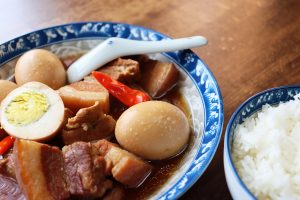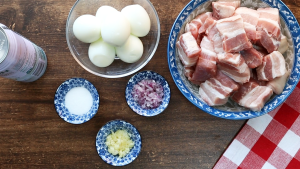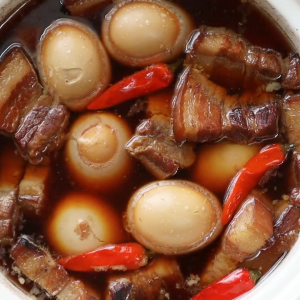Vietnamese Braised Pork & Eggs (Thịt Kho Tàu)

Braised Pork & Eggs, also known as Caramelized Pork & Eggs, is a beloved dish in Vietnamese, Cambodian, and Laotian cuisines. This dish features pork and hard-boiled eggs simmered in coconut juice and is best served with steamed rice.
During the Lunar New Year (Tết) celebrations, Braised Pork & Eggs (Thịt Kho Tàu) is a staple on Vietnamese family dinner tables. The key to its distinctive flavour is the pure coconut juice, harvested from the coconut trees that thrive in Southern Vietnam’s warm climate. This juice imparts a fresh, elegant sweetness that sets the dish apart.
The dish’s popularity also stems from its longevity; it can be stored for several days without the meat and eggs spoiling. Consequently, it is also known as “Thịt Kho Tàu” in Vietnamese, reflecting its practicality as a meal that fishermen could take on long trips away from land.
My great aunt was renowned for her cooking, and her Braised Pork & Eggs was one of her signature dishes. Each visit to her home in Vietnam was marked by the delightful anticipation of enjoying this cherished meal.
Here are a few notes on my Vietnamese Braised Pork & Eggs recipe:
- I blanch the pork belly and then clean it before cooking. Although this step takes extra time, it helps remove the porky taste and ensures the meat is cleaner.
- Use “coconut juice” or “coconut water” instead of “coconut milk” or “coconut cream.” Coconut milk or cream can make the broth cloudy, which isn’t ideal for this dish. Fresh coconut juice is preferable, but canned coconut juice works well too.

Q&As on Vietnamese Braised Pork & Eggs
1. Why is pork belly the preferred choice for this dish, and can I use other cuts of pork?
Pork belly is the ideal choice for this dish because of its perfect balance of meat and fat. The fat renders during cooking, creating a rich, flavourful, and tender texture that enhances the overall taste of the dish. Other cuts of pork, such as loin or shoulder, lack the same amount of fat, which can result in a less rich and juicy dish. Pork belly provides the essential caramelized, melt-in-your-mouth quality that defines this recipe.
2. Can I use quail eggs instead of regular chicken or duck eggs for this dish?
Yes, you can use quail eggs in place of regular chicken or duck eggs for this dish. Quail eggs will add a unique touch and slightly different flavour.
3. How long does it typically take to cook this dish?
The total cooking time for this dish is generally around 1 hour. This includes approximately 30 minutes for simmering the pork belly and another 30 minutes after adding the hard-boiled eggs. This allows the flavours to meld together and ensures the pork is tender and fully cooked. Adjust the time as needed based on your stove and the size of the pork pieces.

4. What defines an authentic Vietnamese Braised Pork & Eggs dish?
An authentic Vietnamese Braised Pork & Eggs dish, also known as “Thịt Kho Tàu,” is characterized by several key elements.
It features pork belly, which provides a rich and tender texture due to its balance of meat and fat. The dish is braised in a combination of coconut juice and fish sauce, which imparts a distinct sweet and savoury flavour. Caramelized sugar is used to create a deep, rich colour and enhance the overall taste. Hard-boiled eggs are added during the cooking process, absorbing the flavours of the braise. Authentic preparation also involves simmering the dish for a substantial amount of time to ensure the pork is tender and the flavours are well-developed. Freshly ground shallots and garlic are commonly used for seasoning, contributing to the dish’s aromatic depth.
5. How do you say this dish in Vietnamese, and what is its pronunciation?
In Vietnamese, this dish is called “Thịt Kho Tàu.” It is pronounced “teet khaw tau.”
- Thịt (teet) means “meat.”
- Kho (khaw) means “braised” or “stewed.”
- Tàu (tau) means “boat.”
The pronunciation of “Thịt Kho Tàu” can be broken down as follows:
- Thịt: rhymes with “seat” but with a softer “t” sound.
- Kho: sounds like “kaw,” with a soft “k” sound.
Tàu: pronounced “tau,” rhyming with “how.”

Recipe for Vietnamese Braised Pork & Eggs (Thịt Kho Tàu)
Equipment
- 1 small pot for blanching the pork belly
- 1 medium pot for cooking the dish
Ingredients
- 1.5 lbs pork belly steak, cut into bite-sized pieces
- 6 hard-boiled eggs, peeled
- 1 can (520 ml) coconut water
- 1 tablespoon sugar
- 1 tablespoon finely chopped shallots
- 1 tablespoon finely chopped garlic
- Thai chili peppers optional
- For seasoning: Mushroom powder, fish sauce
Instructions
- Begin by adding water to a large pot and bringing it to a rolling boil. Carefully add the pork belly pieces to the boiling water. Allow the pork to cook for approximately 10 minutes. This step helps to remove excess impurities and blood, resulting in a cleaner-tasting dish. Once the pork is blanched, drain it from the pot and rinse it under cold water to remove any remaining impurities.
- In a separate pot, heat a small amount of cooking oil over medium-high heat. Add the sugar to the pot, stirring gently. Continue stirring until the sugar melts and transforms into a rich, golden-brown caramel. Be cautious not to let the sugar burn, as it should develop a deep colour but not a bitter taste.
- Once the sugar has caramelized, add the blanched pork belly pieces to the pot. Stir well to ensure that each piece of pork is evenly coated with the caramelized sugar. Add the freshly chopped shallots and garlic to the pot, stirring to combine. Season the mixture with fish sauce and mushroom powder to taste,allowing the flavours to meld together.
- Pour in the coconut water, adding more water if necessary to ensure the pork is covered. Reduce the heat to medium, allowing the mixture to simmer gently. Cook for about 40 minutes, or until the pork becomes tender and absorbs the flavours of the caramel and seasonings.
- Throughout the cooking process, periodically skim off any impurities or foam that rise to the surface of the pot. This step helps to keep the broth clear.
- Gently add the hard-boiled eggs to the pot. Continue to simmer the dish for an additional 30 minutes. This allows the eggs to absorb the rich flavours of the braise and become infused with the caramelized sauce.
- If you prefer a bit of heat, add Thai chili peppers to the pot. Adjust the amount according to your taste preference.
- Once the cooking time is complete, and the pork and eggs are tender and well-flavoured, the dish is ready to be served. Enjoy the braised pork and eggs with steamed rice for a complete and satisfying meal.

